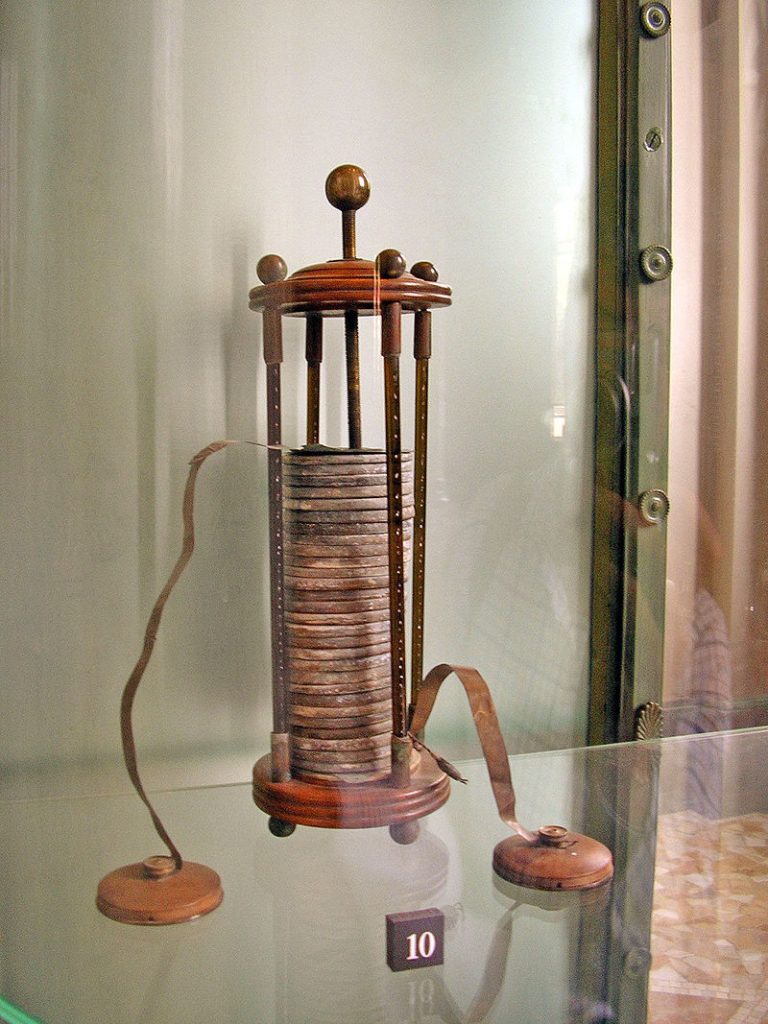Can you imagine a day without a battery? All our devices from smartphones to pacemakers use the power of batteries to harness electricity. These devices play a pivotal role in our society and it is important to give credit where credit is due. You can thank the great Italian scientist Alessandro Volta for his discovery of the first ever battery coined the voltaic pile. If his name sounds a bit familiar it is because the volt (unit for electric potential) is named after him.

Alessandro Volta was born to an aristocratic family in Como, Italy on February 18th, 1745.1 Volta excelled in math and science at a very young age. Even as a school boy he showed a keen interest in electricity. In the eighteenth century, the phenomenon of electricity was an intellectual curiosity, and not much was known about its properties. Volta excelled in school, and in 1774 he became a professor of physics at the Royal School of Como.2 During his time as professor, his interest in electricity remained a focus of his work. He created the electrophorus, which was a device used to generate static electricity.
Volta never set out to invent the battery. His experiments on electricity were in response to the claims of a scientist and friend of his, who claimed to have found electricity in animals.3 This scientist was Luigi Galvani, a professor of anatomy at the University of Bologna. One day as Galvani was performing an experiment on frogs, he began to cut the legs so that they would be exposed. When he touched his steel scalpel with a brass hook holding the frog’s legs in place, he saw the legs twitch. Galvani was convinced that what was going on was the presence of animal electricity. Galvani thought the muscles of the frog stored its life force. When Volta learned about Galvani’s discovery of animal electricity, he went right away to try to replicate Galvani’s experiment. Volta wanted to see for his own eyes what Galvani had published to the scientific community about his new discovery. After completing the experiment dozens of times, Volta disagreed with Galvani. Volta believed that the movement of the frog legs were because of the electric stimulation that was provided by the steel scalpel and the brass hook.4 Volta concluded that the frog’s legs were merely a vessel for the electric stimulation.

Once Volta recreated Galvani’s experiment, he knew the key to producing electricity was by using two metals that were not the same and not the actual frog legs themselves. The frog legs could not produce any sort of electricity. The reason the frog legs would move was because of the charge which was sent through the frog legs and into the nerves inside the legs which in turn resulted in a twitch. This was an indication that electricity was present. Volta recreated the experiment but would later conclude the frog legs were not the only electricity indicators but so were other materials such as moist cards of brine, or cardboard soaked in salt water. This was when Galvani concluded that the electric charge came from the rods of metal themselves and had nothing to do with frog legs. For the first experiment he used five cups with brine or salt water in them. Then, by adding pieces of silver and zinc, he attached the cups by metal strips where he placed them into the cups of brine. He would then put one finger at each end of the cups to feel the slight electric shock. Impressed with his work, he wanted to see if he could recreate his experiment, but without all the brine water. He then created a circuit consisting of copper and zinc discs that were separated by a cardboard soaked in brine. Just by adding more copper, cardboard soaked in brine, and zinc, Volta was able to adjust the amount of electricity that was being produced by the circuit. This became the voltaic pile, the first battery with a reliable source of electricity. Once Volta realized what he had done, he was able to refute the idea Galvani proposed about animal electricity.

Volta published his experiment and findings to the scientific community and later was honored for his invention of the voltaic pile. Today it is now almost impossible to not be in constant contact with a battery. You can thank Alessandro Volta for his discovery of the battery, which became a template for our modern dry-cell batteries. We might also thank Luigi Galvani for his role in stimulating Volta’s experiments, and maybe even thank the many nameless frogs for their contributions.
- Oliver J. Thatcher, The Library of Original Sources (New York, Chicago: University Research Extension, 1907), 395. ↵
- Encyclopedia of World Biography, 2004, s.v. “Alessandro Volta,” by Paula K. Byers. ↵
- Joost Mertens, “Shocks and Sparks: The Voltaic Pile as a Demonstration Device,” The History of Science Society 89, no. 2 (June 1998): 303. ↵
- Giuliano Pancaldi, Volta: Science and Culture in the Age of Enlightenment (Princeton University Press, May 1, 2005), 110. ↵



51 comments
Blanca Martinez
Great article, it was pretty informative, had many things I had never really paid attention to. I recognized the name but never paid much thought to it so it’s kind of awesome to finally put a face to the name. The usage of frogs is quite surprising, who would have thought that the jumping of a frog’s leg would give so much Intel on our now every day needed batteries.
Sam Vandenbrink
I really liked the way this article started out, really hooking you in with talking about this relevant to the time now. Because technology really does play a vital role in our society and it all leads back to him. I think that everyone reading this article can thank this guy, because they wouldn’t be reading it unless he invented the battery Impressive guy! Very well written article!
Briana Myers
We use batteries on a daily basis and I am pretty sure that most of us had no idea how they came to be or who invented them. I did not know about this until I read this article. It is very interesting how the dissecting of frogs is what led to the creation of batteries. Of course it was not the actual frog that created the electricity but the metals touching from the tools that were being used.
Sebastian Castro Ramos
I always enjoy reading scientific articles like this one. I didn’t know about how the battery was invented, and it is peculiar how it came to be, because of frogs. The role of Galvani and his experiments with frogs were also important influences for Volta’s pursue to prove him wrong, which led to Volta’s discoveries. And who would have guessed his discoveries and invention would have such an impact on the development of the world we live in.
Deanna Lummus
I find this article to be most inspiring. It is very clear and interesting all at the same time. I love how basic experiments can cause major effects. Anyone could try it out for themselves. This makes me want to do some experiments of my own just to experience what Alessandro Volta did. It was also interesting to hear how the word “volt” came about. There are a lot of words we say today that come from peoples names that we don’t even know about.
Erik Shannon
This was a very good article. I never knew how the battery was first used. It’s crazy how far batteries have developed to current day. We use batteries for so many things in our everyday lives. I never knew that frog legs were used to make and run the first batteries. Overall, this was a very good and unique article.
Eduardo Foster
It’s interesting how the batteries were created! Even though it included animal abuse but at the end it lead to one of the most use invention now in days. Most of the technology we use today requires batteries in order to work. Actually very interesting article and didn’t knee about Volta and his invention before! Keep it up with the good work!
Cherice Leach
I didn’t even know there was a specific someone to thank for the amazing invention of the battery. It’s kind of one of those things we don’t care to think about but it’s interesting to know that there is someone to credit. Science is interesting and it’s cool to know that they thought animals created electricity in their bodies. It’s also cool to note that they were using frogs for physics experiments and not just biology experiments haha.
Alejandra Mendez
The reason why this article caught my attention was the word ‘frogs’ in the same sentence as ‘battery’. Never would I have thought that a frog’s twitching leg led to the invention of a battery. I figured from past assumption that the battery was probably made by accident by the touching of two metals, but I would have never thought of a frog, let alone its dancing legs, being involved as well. This was a very interesting article and I definitely learned something new by reading it.
Rafael Azuaje
As I type this comment I’m listening to music on wireless headphones that have an eight hour battery life. The cell phone that I’m streaming the music from has around 8-10 hours of battery life. Volta ran the experiment with frog legs trying to recreate the results of his friend Luigi Galvani. But not only did he do that – he took his observations and used them as a basis for subsequent experimentation. I am glad he did. I just wish he didn’t have to use those frogs like that.